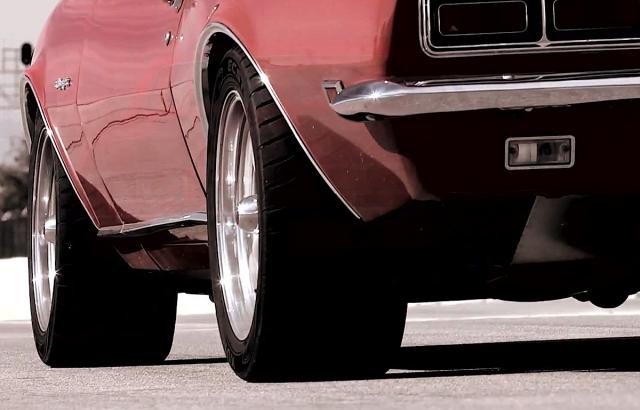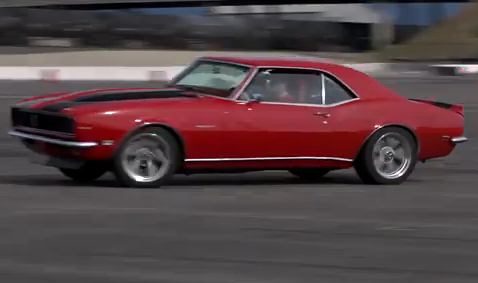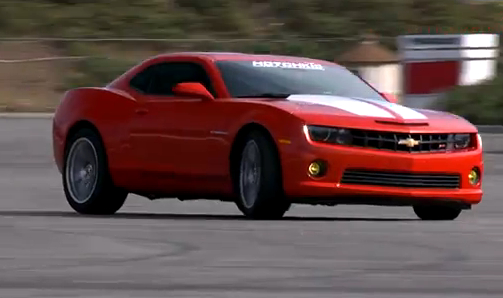Josh Jacquot, Senior Editor at Insideline.com, had the idea to do something that we’ve all dreamed of, comparing cars from different eras in the same family. We absolutely loved the novel approach Jacquot took when making the comparison test of vintage and new Camaros, pitting one against the other, in a neutral environment without letting current technology tilt the performance edge in favor of the newer Camaro.
 Jacquot found a vintage ’68 Camaro that had been modified with a supercharger and supported with a modern fuel system and cooling system and some suspension fabrication that upgraded the fourty-four year old chassis to a more mild mannered performance muscle car.
Jacquot found a vintage ’68 Camaro that had been modified with a supercharger and supported with a modern fuel system and cooling system and some suspension fabrication that upgraded the fourty-four year old chassis to a more mild mannered performance muscle car.
Car owner Carl Casanova, the fabricator and wrench behind the vintage Camaro, routinely runs the machine on Southern California racetracks, putting the car through it’s paces before rolling it back into the garage for routine maintenance.
Casanova has owned the car for thirty years and its clear that he believes vintage muscle cars are meant to be driven… and driven hard. Jacquot pitted the vintage Camaro with the latest version in the family lineage, a 2011 Camaro outfitted with a Magnuson supercharger and a suspension kit from Hotchkis Sport Suspension.
Carl Casanova’s 1968 Camaro
Jacquot points out that Casanova did all the work to the vintage Camaro himself. Upgrading performance while keeping the soul of the car intact was the overall goal. Hand fabricating everything to keep it as close to original appearing as possible, Casanova hand-fabricated the six-spot gauge cluster and built the circulation system for the air-to-liquid intercooler with his own hands. Other components in the build were selected by Casanova to maintain the heartbeat of the late sixties while improving the performance to meet the advances in technology.
Casanova’s Camaro Specs:
- LS1 V8 is from a 2002 Camaro.
- Supercharger and accompanying parts come from Magnuson’s Hot Rod Kit, which was originally intended for a 2004 Pontiac GTO.
- Six-speed Tremec T56 transmission from the same fourth-generation Camaro as the engine.
- Transmission gear ratios: 1st=2.66, 2nd= 1.78, 3rd= 1.30, 4th=1.00, 5th=0.74, 6th=0.50
- Eaton Positraction limited-slip differential
- 3.73 : 1 final drive ratio
- The front brake rotors and calipers are from a C4 Corvette and the rears are from a ’90s-vintage Z28 Camaro. A Chevy HHR master cylinder pressurizes the system
- Wheels are V45s from Vintage Wheel Works 17X9.5-inch
- Tires are Kumho Ecsta XS P285/40R17
- Hotchkis’ Total Vehicle suspension system and includes all four front control arms, both stabilizer bars, front coil springs and rear leafs as well as Bilstein shocks
The 2011 Camaro reportedly rolled off the GM line in Oshawa, Ontario in 2010 where it found its way to a Southern California dealer before getting purchased by Hotchkis. Naturally, the stock suspension was removed and replaced with Hotchkis parts for premium handling and control of the 3,925 pound machine.
Hotchkis’ 2011 Camaro Specs:
- 6.2-liter V8 with JBA long-tube headers and a Flowmaster exhaust.
- Magnuson supercharger
- Centerforce clutch
- Six-speed manual transmission
- Transmission gear ratios: 1st=3.01, 2nd=2.07, 3rd=1.43, 4th=1.00, 5th=0.84, 6th=0.57
- Limited-slip differential.
- 3.45:1 final drive ratio.
- The front brake rotors and calipers are 14-inch one-piece ventilated cast-iron discs with four-piston fixed calipers.
- Wheels are BBS CH 20X9-/20×10-inch front/rear
- Tires are Nitto NT05 P275/40ZR20 (Front) P315/35ZR20 (Rear)
- Independent MacPherson struts, coil springs, stabilizer bar front suspension
- Independent multilink, coil springs, stabilizer bar rear suspension
Notes and Observations:
According to Jacquot, the drag strip test favored the 2011 Camaro, “demonstrating the new car’s superior power-to-the ground abilities. Plentiful road-crushing mass and another few inches of rear rubber will do that,” adding “when it comes to stopping, there’s no substitute for antilock brakes. Sixteen feet separate the two (127 feet vs. 111 feet) when hauling down from 60 mph. This test, unsurprisingly, fell in favor of the new car.”
 The editor was quick to point out that the comparison was not all about numbers however. Putting it frankly, Jacquot said, “Let’s be honest. The modern Camaro isn’t a car that triggers emotion like the original.”
The editor was quick to point out that the comparison was not all about numbers however. Putting it frankly, Jacquot said, “Let’s be honest. The modern Camaro isn’t a car that triggers emotion like the original.”
To prove that point, the test crew drove the cars together in the beautiful Southern California region to gauge public opinion. Summing it up in a quick statement that gets right to the point, Jacquot says, “One is a legend, and the other wants to be. And it’s trying hard.”
Sounds to us like the crew at insideline.com gave the edge to the vintage car but liked the direction that Camaros were heading for the future.





















